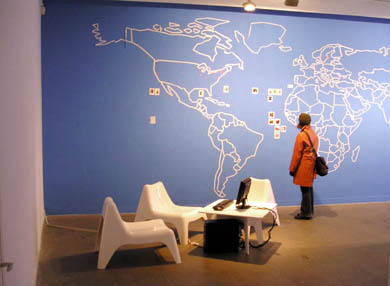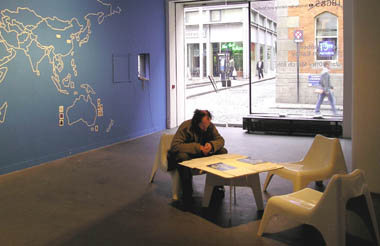Utopia seems to be something of a buzzword in the current international art scene, with artists such as Marjetica Potrc, Rirkrit Tiravanija, Andrea Zittel and Liam Gillick all referencing ideas concerned with the meaning and uses of architecture, the dismantling of the modernist project, and new, pragmatic reworkings of naïve utopian ideals. The Ocean Earth Corporation, headed up by Peter Fend, Danish collective Superflex and N55 are three of a growing number of artist collectives striving to implement ecological and social change; though conducting their activities and choosing to present their work in art institutions, it also functions outside of this microsystem. In all of this, the gallery location is implicitly constructed as a separate mental space that somehow provides room for imagining, optimistic dreaming, and a testing ground for presenting new possibilities (albeit to a select ‘art’ audience in most cases).
 |
Jon Brunberg, 2004: Visions for the Fututre of Mankind,world map (wall drawing) charting progress of the World Utopian Essay Writing Contest, and web station with IKEA furniture, installation view at the Temple Bar Gallery; courtesy TBG |
Contextually, this show at TBG fits with this larger body of work that is flourishing in international art centres outside Dublin, and also recalls the spirit of the Utopias show in the Douglas Hyde a couple of years back. Flexibilty, networking of ideas and people, freedom with materials and open-endedness of meaning characterise this work. Resisting simplistic or closed readings, Earley’s work weaves together contrasts of scale, relating the body to the built environment and using miniature architectural models. Further contrasts between high-tech and low-tech technologies are also used (a ‘home-made’ video projector; a camera obscura). The body is worked as well as the mind: a physical presence is evoked in the lens-based work, highly unusual for a medium that tends to privilege the visual and mental faculties. The physical energy required to develop and print the camera obscura image is documented through a video piece on the wall, which shows the use of huge pieces of photographic paper, taped together; large rollers on sticks being used to roll on the chemicals; carrying the print into the bathroom and washing it in the bathÉ the process of making this work stretches to the limit the scale of the body making it and the bounds of domesticity in which it is made. The production of this work challenges the scale of activity in the modernist housing block that it representsÉphysical presence is embedded in this work through its means of production and the work speaks of action and agency within the architecture rather than being trapped or pacified by it.
Other works on show include meticulously detailed marker drawings of towerblocks; particular and anonymous at the same time. Though specific drawings of St. Michael’s Estate, Ballymun, they speak the universal, levelling language of modernist architecture. This same familiarity is evoked with a clever video piece that inititally appears to be a cityscape filmed at night using an infrared camera, but is in actuality a model landscape constructed from polystyrene in the artist’s studio.
  |
Brendan Earley: (left) drawing,marker on paper, and (right) City at Night, still from video; courtesy Temple Bar Gallery |
Methods of improvisation and ‘making do’ are used as a strategy to use and appropriate mass-produced homogenous materials in an individual way (typically readymade, industrial materials such as polystyrene, scaffolding, plastic wrapping, construction tape). There is a play between precision (finely ordered lenses and electronics to make the video projector) and roughness (the two pieces of photographic paper crudely joined with duct tape). ‘Skill’ is used as necessary for the particular task and not as an end in itself; some exercises are more technical than others. The means of display (the electronics) are rendered visible and transparent, not covered with plastic or inserted behind the gallery wall, but simply attached to it. The means of covering or decorating are stripped away, a rare thing. This work is lean and there are no excesses wasted: the means of display are in fact integral to its concept, serving to highlight the work’s concerns rather than obscure them.
The other work in show has somewhat similar concerns that are articulated differently and with different means. Brunberg’s work also deals with the problematic legacy of modernism, but is primarily a mentally focused activity rather than a physical one and uses the virtual space of the internet. The installation in the gallery consists of a large map of the world imposed onto one wall using white tape on a blue background, and two seating areas with reading material and live internet access. (In a tongue-in-cheek nod to its utopian ideals, the furniture is supplied by BrunbergÕs native Swedish brand, IKEA, with the aspiration of providing cheap and affordable furnishings to all). The map charts some of the previous locations of the tour, some of the previous participants and last yearÕs winner and Temple Bar Gallery becomes one of many dots on the map; a base of operations for BrunbergÕs worldwide utopian essay-writing contest. This work, though apparently rigidly structured and relying on technology, is actually a living work that changes, grows, diversifies as the network of participants expands. These ideas of mapping fluid networks of people across a global scale are becoming more and more visible and imporant as the influence of globalisation makes its presence felt on the worldwide art community, and the model of art presentation that is Ôthe biennial circuitÕ becomes increasingly popular.
 |
Jon Brunberg, 2004: Visions for the Future of Mankind, reading station with IKEA furniture, installation view at the Temple Bar Gallery; courtesy TBGS |
Though the project inhabits a virtual space, it also occupies the gallery, thus once again embracing the idea of the gallery as a location of possibilty and optimism, if not outright idealism (institutional critique has fallen out of fashion these days). It is appropriate that the virtual space of the internet is the forum for a discussion of utopia, the root of the word as originally used by Thomas More meaning both paradise, and literally (from u-topos ), a non-place. The work does however also have a material reality in the publication of textual material, and more importantly, in the contact and dialogue sparked between its participants.
The two artists in the show play well off each other, serving to relate the local (Earley) to the global (Brunberg), and the complexities and overlaps of this relationship. The cynicism and suspicion of the art gallery as a ‘neutral’ public space seems to have been dropped in favour of acceptance and the recognition that there is no ‘outside’; however, although this work is based on the spirit of compomise, it does not compromise itself . This work by Brunberg and Earley does not offer concrete solutions, but it does attempt to open up a space for dialogue – and this is not a closed conversation.
Sarah Browne is an artist and writer currently based in Co. Kildare.
Jon Brunberg and Brendan Earley at Temple Bar Gallery and Studios, January 30 to March 6, 2004. See also http://www.soc.nu/utopian/index.html to enter The Utopian World Championship.